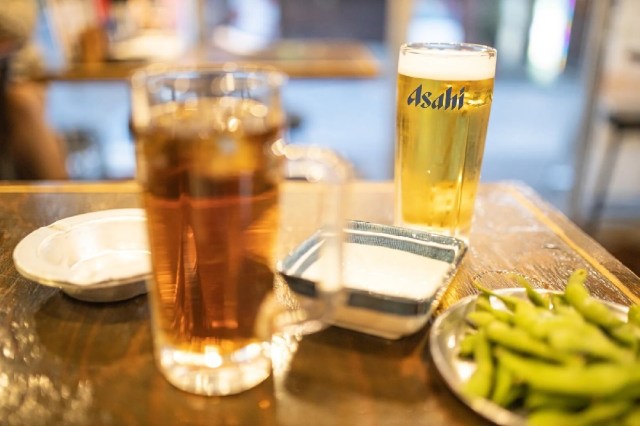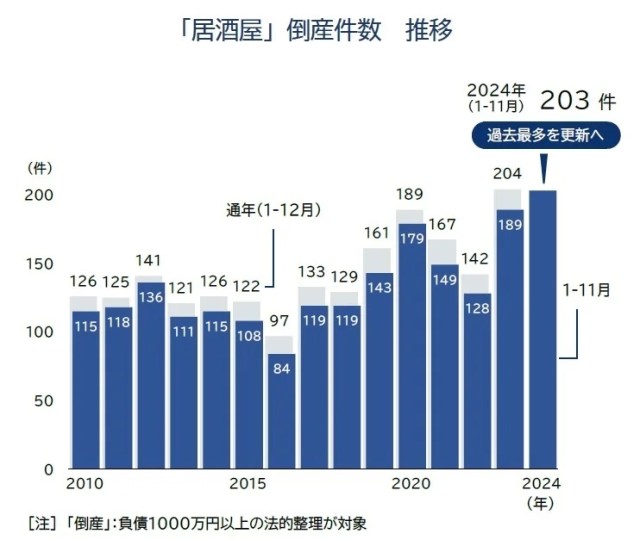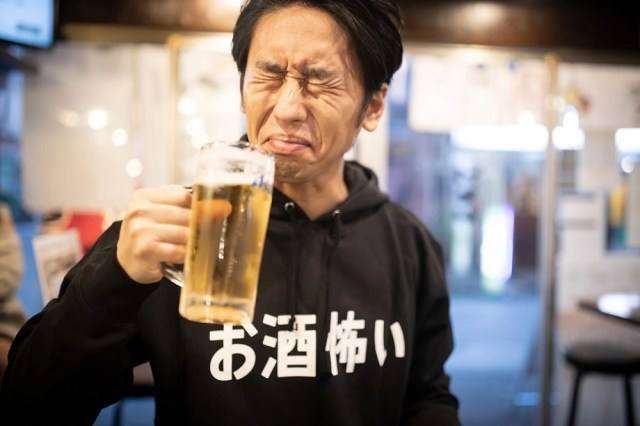
More Japanese pubs are declaring bankruptcy now than in any year of the pandemic, study says.
In Japan, you’ll come across a couple of different sub-classifications of restaurants. There are senmonten, “specialized shops” that focus on variations of a single dish, like beef bowls or ramen. There are teishokuya, which serve a variety of set meals with a main dish accompanied by rice, vegetables, and miso soup. And then there are izakaya, pubs that offer a wide array of alcoholic beverages and sides such as skewers of grilled chicken, plates of sashimi, and bowls of edamame.
Because of the extensive variety of their offerings and how easily sharable their food is, izakaya are a popular choice for a couple of cold ones and a bite to eat…but the results of a recent study by Japan’s Teikoku Databank research firm shows that izakaya are in a shaky spot these days, with 2024 on pace for the largest number of izakaya bankruptcies in more than a decade.
According to Teikoku Databank’s findings, through November of this year 203 izakaya have declared bankruptcy (defined in the study as declarable with debts of over 10 million yen [approximately US$67,000]). That’s higher than any January-November period in the past 15 years, and up 7 percent compared to 2023. What’s more, no year between 2010 and 2023 had more than 204 izakaya bankruptcies for the entire year, so once this December’s numbers are added in to the 2024 total, it’s almost certain to set a new record.
▼ The study’s figures, showing izakaya bankruptcies between 2010 and 2024 for the first 11 months of the year in blue, and for the entire year in gray.
Obviously, there was a spike in izakaya bankruptcies during the pandemic, with 189 in 2020. But while bankruptcies dipped in the latter half of the health crisis, a massive jump occurred in 2023 with 204, more than in any single year of the pandemic, and things are going to be bleaker still in 2024.
So what’s going on here? Teikoku Databank cites changes in consumer spending habits, as well as rising costs for alcoholic beverages, food, and labor, and those factors are likely feeding into one another in a vicious cycle.
Starting with the first part, izakaya have long benefited from having large groups of customers come in for company drinking parties, as well as smaller groups of coworkers stopping in for an informal round or two on their way home from the office. That practice got put on hold during the pandemic as work-from-home and social distancing became the norm, and it hasn’t made a 100-percent comeback, with a lot of Japanese workers now more acutely aware that they’d rather spend their time doing something other than drinking with coworkers after clocking out as a result of being freed from such obligations for a few years.
▼ Even if you close your eyes, drinking with your blowhard boss will still feel like work.
Meanwhile, a weakened yen is resulting in all sorts of rising prices in Japan. With the country experiencing its worst inflation in a generation, restaurants have been steadily increasing their prices in order to protect their profit margins. However, it’s not just izakaya that are paying more for cooking ingredients, electricity, and delivery costs. Necessary living expenses like groceries, utilities, train fares, and gasoline are all rising for consumers too, and outpacing increases to workers’ wages.
In other words, izakaya are charging higher prices while potential customers have less money to spend, which is coinciding with an increased number of people having recently confirmed that they’d be OK with making fewer izakaya visits anyway. That’s not a very reliable recipe for financial success, and until some of the contributing factors change, the izakaya bankruptcy situation might get worse before it gets better, so it might be time for us to up our senbero game.
Source: PR Times, Teikoku Databank via Ryutsu News
Top image: Pakutaso
Insert images: PR Times, Pakutaso
● Want to hear about SoraNews24’s latest articles as soon as they’re published? Follow us on Facebook and Twitter!



 Bento bankruptcies increasing as Japan’s boxed lunch shops struggle in the new dining landscape
Bento bankruptcies increasing as Japan’s boxed lunch shops struggle in the new dining landscape Japanese wife creates izakaya pub at home during coronavirus outbreak
Japanese wife creates izakaya pub at home during coronavirus outbreak Subway Japan purchased by Japanese izakaya pub company with penchant for organic farming
Subway Japan purchased by Japanese izakaya pub company with penchant for organic farming Japanese pubs in Tokyo, Osaka now have special seats for online drinking party customers
Japanese pubs in Tokyo, Osaka now have special seats for online drinking party customers We create a Japanese izakaya pub at home with an amazing all-in-one kitchen gadget
We create a Japanese izakaya pub at home with an amazing all-in-one kitchen gadget KFC Japan opens a Christmas restaurant in Tokyo…but why???
KFC Japan opens a Christmas restaurant in Tokyo…but why??? Japan’s EF English Proficiency Index rank drops for 11th straight year, hits lowest ever
Japan’s EF English Proficiency Index rank drops for 11th straight year, hits lowest ever Japan considering raising international traveler departure tax even more than previously reported
Japan considering raising international traveler departure tax even more than previously reported Japan’s Shinkansen trains are getting a Super Mario makeover【Pics】
Japan’s Shinkansen trains are getting a Super Mario makeover【Pics】 Chinese government’s don’t-go-to-Japan warning has heartwarming non-effect on Yokohama Chinatown
Chinese government’s don’t-go-to-Japan warning has heartwarming non-effect on Yokohama Chinatown Is it OK to split the bill on a date in Japan? Survey asks what women and men of different ages think
Is it OK to split the bill on a date in Japan? Survey asks what women and men of different ages think Japan’s Super Colossal Mega Parfait is so freakishly huge it comes in a beer pitcher【Taste test】
Japan’s Super Colossal Mega Parfait is so freakishly huge it comes in a beer pitcher【Taste test】 Yoshinoya’s new ramen doesn’t smell like it tastes【Taste test】
Yoshinoya’s new ramen doesn’t smell like it tastes【Taste test】 One Piece devil fruit ice cream coming back to Baskin-Robbins Japan
One Piece devil fruit ice cream coming back to Baskin-Robbins Japan Godzilla-shaped ice cream on sale in Tokyo near the sight his most adorable rampage
Godzilla-shaped ice cream on sale in Tokyo near the sight his most adorable rampage Japan’s human washing machines will go on sale to general public, demos to be held in Tokyo
Japan’s human washing machines will go on sale to general public, demos to be held in Tokyo Japanese train company is letting fans buy its actual ticket gates for their homes
Japanese train company is letting fans buy its actual ticket gates for their homes Yoshinoya adds first-ever chain-wide ramen with new beef and pork-broth noodle hot pot meals
Yoshinoya adds first-ever chain-wide ramen with new beef and pork-broth noodle hot pot meals Nintendo’s Kirby now delivering orders at Kura Sushi restaurants, but not in Japan
Nintendo’s Kirby now delivering orders at Kura Sushi restaurants, but not in Japan Is China’s don’t-go-to-Japan warning affecting tourist crowds in Shibuya’s Don Quijote?
Is China’s don’t-go-to-Japan warning affecting tourist crowds in Shibuya’s Don Quijote? Is China’s don’t-go-to-Japan warning affecting tourist crowd sizes in Nara?
Is China’s don’t-go-to-Japan warning affecting tourist crowd sizes in Nara? Studio Ghibli stamps lift your spirits with motivational phrases from Totoro
Studio Ghibli stamps lift your spirits with motivational phrases from Totoro New fish discovered and named “Vanderhorstia supersaiyan” for obvious reasons
New fish discovered and named “Vanderhorstia supersaiyan” for obvious reasons Japanese town suing resident for being a jerk
Japanese town suing resident for being a jerk Starbucks Japan unveils new Christmas goods and a rhinestone tumbler that costs 19,500 yen
Starbucks Japan unveils new Christmas goods and a rhinestone tumbler that costs 19,500 yen Real-world Nausicaa Ghibli anime glider completes its final flight in Japan【Video】
Real-world Nausicaa Ghibli anime glider completes its final flight in Japan【Video】 Brand-new Pokémon park opens in Japan with larger-than-life-size Lapras【Photos】
Brand-new Pokémon park opens in Japan with larger-than-life-size Lapras【Photos】 Unique inclined elevator in Japan leads to a town that inspired Studio Ghibli’s Spirited Away
Unique inclined elevator in Japan leads to a town that inspired Studio Ghibli’s Spirited Away Is China’s don’t-go-to-Japan warning affecting tourist crowds in Tokyo’s Asakusa neighborhood?
Is China’s don’t-go-to-Japan warning affecting tourist crowds in Tokyo’s Asakusa neighborhood? The 10 best day trips from downtown Tokyo【Survey】
The 10 best day trips from downtown Tokyo【Survey】 Naturally brown-haired Osaka student sues government for forcing her to dye her hair black
Naturally brown-haired Osaka student sues government for forcing her to dye her hair black Tokyo hotel lets you make your stay a Sanrio one with special My Melody and Kuromi rooms【Pics】
Tokyo hotel lets you make your stay a Sanrio one with special My Melody and Kuromi rooms【Pics】 Survey asks foreign tourists what bothered them in Japan, more than half gave same answer
Survey asks foreign tourists what bothered them in Japan, more than half gave same answer Japan’s deadliest food claims more victims, but why do people keep eating it for New Year’s?
Japan’s deadliest food claims more victims, but why do people keep eating it for New Year’s? We deeply regret going into this tunnel on our walk in the mountains of Japan
We deeply regret going into this tunnel on our walk in the mountains of Japan Studio Ghibli releases Kodama forest spirits from Princess Mononoke to light up your home
Studio Ghibli releases Kodama forest spirits from Princess Mononoke to light up your home Major Japanese hotel chain says reservations via overseas booking sites may not be valid
Major Japanese hotel chain says reservations via overseas booking sites may not be valid Put sesame oil in your coffee? Japanese maker says it’s the best way to start your day【Taste test】
Put sesame oil in your coffee? Japanese maker says it’s the best way to start your day【Taste test】 The top 10 annoying foreign tourist behaviors on trains, as chosen by Japanese people【Survey】
The top 10 annoying foreign tourist behaviors on trains, as chosen by Japanese people【Survey】 No more using real katana for tourism activities, Japan’s National Police Agency says
No more using real katana for tourism activities, Japan’s National Police Agency says J-pop mega star Ado reveals she’s been living in the U.S., may not understand language acquisition
J-pop mega star Ado reveals she’s been living in the U.S., may not understand language acquisition This Japanese pub with one-yen bottles of sake broke our brain and made our day
This Japanese pub with one-yen bottles of sake broke our brain and made our day As more foreign visitors visit Kyoto’s top sights, Japanese travelers increasingly staying away
As more foreign visitors visit Kyoto’s top sights, Japanese travelers increasingly staying away Anime Industry Report shows overseas anime market is bigger than Japanese one, but is this a cultural tipping point?
Anime Industry Report shows overseas anime market is bigger than Japanese one, but is this a cultural tipping point? Okinawa pub posts “Japanese only” admission sign based on some shaky logic
Okinawa pub posts “Japanese only” admission sign based on some shaky logic Japanese anime industry is earning more money than ever, almost half of it from outside Japan
Japanese anime industry is earning more money than ever, almost half of it from outside Japan Number of foreigners studying Japanese in Japan hits record high, but are there enough teachers?
Number of foreigners studying Japanese in Japan hits record high, but are there enough teachers? Survey shows drop in Japanese highschoolers who’ve kissed someone, girls still more experienced
Survey shows drop in Japanese highschoolers who’ve kissed someone, girls still more experienced
Leave a Reply